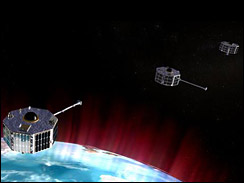 Just after six yesterday morning a Pegasus rocket launched from the belly of a Lockheed L-1011 jet flying 7 miles above the Earth carried a historic payload into space. On board the rocket were three ST5 micro-satellites destined to study the Earth’s magnetic fields from their extraterrestrial orbits. Built as part of NASA’s New Millennium Program, which was created to speed up space exploration through the development cutting-edge technologies, the 55 pound ST5s utilize a tiny antenna that was designed by dozens of computers running a “survival of the fittest” evolutionary algorithm in parallel to determine its optimal shape and size. The successful deployment is the first time an AI-designed system has been put into operation in space.
Just after six yesterday morning a Pegasus rocket launched from the belly of a Lockheed L-1011 jet flying 7 miles above the Earth carried a historic payload into space. On board the rocket were three ST5 micro-satellites destined to study the Earth’s magnetic fields from their extraterrestrial orbits. Built as part of NASA’s New Millennium Program, which was created to speed up space exploration through the development cutting-edge technologies, the 55 pound ST5s utilize a tiny antenna that was designed by dozens of computers running a “survival of the fittest” evolutionary algorithm in parallel to determine its optimal shape and size. The successful deployment is the first time an AI-designed system has been put into operation in space.
The launch was to have taken place a week ago but was scrubbed when a locking pin on the Pegasus rocket iced up and would not release to permit the rocket to launch. The ST5s are expected to remain operational for at least 90 days, and NASA hopes the mission will prove the benefits of using multiple small, low-cost satellites to concurrently study the magnetosphere.
